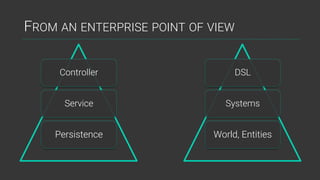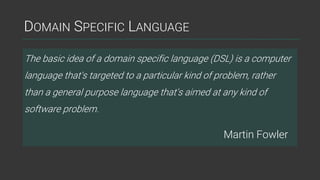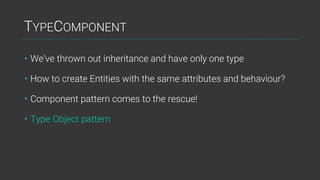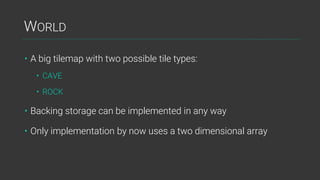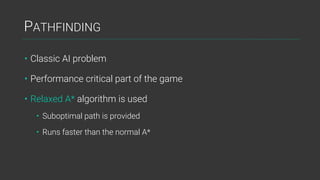InfectNet Technical
- 1. InfectNet The most infectious browser-game ever! Marianna Szabó István Lakatos Attila Bagossy
- 3. WHAT IS IT? • Massively Multiplayer • Code-driven (custom DSL) • Computer Virus Themed • Pseudo Realtime Strategy Game
- 4. WORKFLOW • Version Control git • Development Flow nvie/gitflow • Methodology Kanban • Kanban Board Waffle • Continuous Integration Travis CI • Static Analysis Tool Codacy
- 5. PROJECT REPOSITORIES PARENT REPOSITORY https://github.com/infectnet/infectnet-parent Does not contain any code, but description of the common development policies among other repositories. SERVER REPOSITORY https://github.com/infectnet/infectnet-server Hosts the source code of the game server and the game engine. BROWSER FRONTEND REPOSITORY https://github.com/infectnet/infectnet-browser-frontend Browser-based frontend for the game.
- 6. TECHS THAT POWER – THE SERVER • Build Tool Gradle • Web Application Framework Spark • Dependency Injection Dagger 2 • Real Time Communication WebSocket • DSL Base Language Groovy • Tesing Framework Spock
- 9. COMPLETE SEPARATION OF CORE/CONTENT Core • Defines interfaces to be implemented • Self-contained, can run without content • Provides the glue code that connects different engine parts Content • Implementations of engine interfaces • Must be imported into the engine • The puzzle parts that fit into the holes of the engine
- 11. FROM AN ENTERPRISE POINT OF VIEW Controller Service Persistence DSL Systems World, Entities
- 13. DOMAIN SPECIFIC LANGUAGE The basic idea of a domain specific language (DSL) is a computer language that's targeted to a particular kind of problem, rather than a general purpose language that's aimed at any kind of software problem. Martin Fowler
- 14. DSL – FEATURE OVERVIEW • Players can express their intents in a declarative way • Close to the natural language • Groovy-based with our own additions
- 15. 1. SELECT 2. FILTER 3. ACTION • Select the Entities to operate on with Selectors • Predefined Selectors are available as basic building blocks • The players can create their own • Filter the Entities by some condition • Can include any script with any return value • Perform some action on the selected Entities • Select Entities relative to the current ones
- 16. EXAMPLE SFA
- 18. EXAMPLE SFA – DESUGARED
- 19. CODE BEHIND THE ALL KEYWORD
- 20. SYSTEMS
- 21. FORCES – SANDBOXING • Code written by the Player must be sandboxed • It potentially contains illegal actions • Directly modifying game state quickly leads to catastrophy • Players must not escape their own context
- 22. FORCES – DETERMINISM • Source code execution must be deterministic • In the same turn each player must see the same state • Potentially simultaneous execution of player code must not interfere with each other
- 23. FORCES – BEHAVIOUR EXPOSURE • The DSL does not define how to do, just what to do • The behaviour behind the DSL objects must be put somewhere • A behaviour can be altered by non-local aspects Examples: Area-based spells, Player-level bonus, etc.
- 24. ENTITY WRAPPERS • Entities are wrapped into an abstract proxy class called EntityWrapper • Each entity type must have its own wrapper • Actions can be attached to wrappers through traits
- 25. ENTITY WRAPPERS - TRAITS
- 26. ACTIONS (OBJECTS) • Command pattern • Produced by the EntityWrappers • Represents something that the Player wants to do • Stored in the Action Queue (Event Queue pattern)
- 27. SPAWNACTION
- 28. Move Infect Spawn Positon Modification Health Modification Entity Creation Movement System Spawn System Infect System ACTION QUEUE REQUEST QUEUE
- 29. ACTION ONLY SYSTEM • Observes the Action Queue • Registers itself as a listener of specific Action types • When triggered, processes the Action and either • produces a new Request which will be put in the Request Queue, or • Determines some factor that blocks the Action
- 30. WHY DO WE NEED ACTION AND REQUEST? Action • DSL-level abstraction • References the current state • GETS • May fail if has illegal arguments Request • Atomic persistent operation • Packs all information needed to alter the state • SETS • Can be executed 99% times
- 31. REQUEST ONLY SYSTEM • Observes the Request Queue • Registers itself as a listener of specific Request types • When triggered, executes the Request • May put a new Request into the Request Queue
- 32. SYSTEMS • Can listen to both Queues if they want to • Include most of the logic that powers the game • Can be as granular as they should be (separation of concerns)
- 33. WORLD, ENTITIES
- 34. ENTITY • We need a common base class to handle game objects • But game objects are very heterogenous (behaviour, attributes) • Let’s create an inheritance tree! • The tree quickly becomes unmanageable, as DIT increases
- 35. ENTITY • Let’s use the Component pattern instead • Entities become component bags • If a specific component is not necessary for an Entity, Null Object pattern can be used • Only attributes should be stored in components, behaviour is in the Systems
- 36. ENTITY
- 37. TYPECOMPONENT • We’ve thrown out inheritance and have only one type • How to create Entities with the same attributes and behaviour? • Component pattern comes to the rescue! • Type Object pattern
- 38. TYPECOMPONENT • Abstract class • The only abstract method is the one that’s interesting • It’s actually a constructor method for Entities of a given type • Basically we’ve created our own type system in Java
- 39. TYPECOMPONENT • Components store the attributes, but how do TypeComponent determine the behaviour? • TypeComponent to EntityWrapper mapping • Handled by EntityWrapperRepository
- 40. WORLD • A big tilemap with two possible tile types: • CAVE • ROCK • Backing storage can be implemented in any way • Only implementation by now uses a two dimensional array
- 41. WORLD • Exposes low-level operations to the Systems
- 42. WORLD GENERATION • Procedural map generation extends the lifetime of the game • Nobody wants to create 1000x1000 tilemaps manually • Multiple possible strategies • Cellular Automaton • Perlin Noise • Voronoi Diagram based generation
- 43. CELLULAR AUTOMATON • Everybody knows: Game of Life • Alive and dead cells correspond to CAVE and ROCK • Multiple steps/iterations • Can be easily adjusted through the rules and number of steps
- 44. PATHFINDING • Classic AI problem • Performance critical part of the game • Relaxed A* algorithm is used • Suboptimal path is provided • Runs faster than the normal A*
- 45. GAME LOOP
- 46. GAME LOOP • An infinite loop • Initiates player code execution and then publishes the state changes of the World and the Entities • Uses a fixed tick time with a ScheduledExecutorService • Reschedules itself on the Executor when finished
- 48. THANK YOU FOR YOUR ATTENTION!










